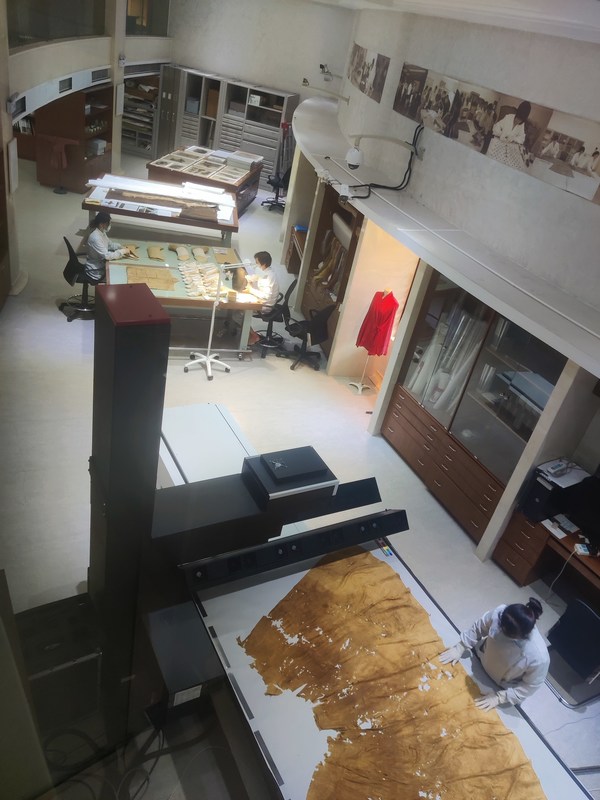China National Silk Museum Shares for the First Time its Conservation Cycle of Cultural Heritage at the 19th ICOM-CC Triennial Conference
HANGZHOU,China,May 20,2021 -- The 19th International Council of Museums - Committee for Conservation (ICOM-CC) Triennial Conferenceis being held virtually this year from May 17-21 in Beijing. In line with this year's theme of "Transcending Boundaries: Integrated Approaches to Conservation," Dr. Zhao Feng,Director of the China National Silk Museum,gave a keynote speech to share with scholars and institutions around the world the conservation cycle of historical textiles based on the realistic best practices of the China National Silk Museum during the last 30 years.

Textile Conservation Gallery of China National Silk Museum
"I am in total awe of the craft skills shown through this presentation and I bow before the Chinesecultural heritage","Very impressive work,congratulations. This research also inspires designers and can add to current fashion",said the participants.
The conservation cycle concept proposed by Dr. Zhao Feng revolves around textile cultural heritages,including emergency conservation measures at the archaeological site,scientific knowledge in the laboratory,restoration and conservation in the museum,preventive conservation for display and storage,digital conservation in the warehouse,the restoration and reproduction ofcultural heritage,and the inheritance of the wisdom of ancient dyeing and weaving.
All the dots can be joined through the collective expertise of the China National Silk Museum in each of these areas. In the face of the challenges of natural disasters and man-made disasters that may be encountered in the conservation of cultural heritages,the conservation cycle method can at least preserve the historical,artistic and scientific value of objects for future generations through the information,data and pictures collected in various links.
Dr. Zhao Feng noted: "We believe that the concept of the conservation cycle can also be promoted at all levels of collection conservation. It can be used in a museum,in a country's industry,and even in the international community of museums. In this spirit the platform is bound to facilitate the broader and better development of the conservation cycle of cultural heritage on a larger scale. The three papers presented by NSM's textile conservator at the ICOM-CC conference and exhibition "Eternal Treasures; China's Treasures in Conservation Collection" created by NSM,are prime examples of the conservation cycle in practice which we are delighted to share. We welcome our international colleagues to join us in a common endeavor to address the challenges in this regard."
This year's ICOM-CC Triennial Conference presented 159 papers and 99 posters throughout the 21 ICOM-CC Working Groups. There was a focus on the latest achievements in various specialized fields of collections conservation with a global perspective and multipledimensions. On this most important of international academic and technical communication platforms for conservators,scholars and institutions,the China National Silk Museum participated extensively and was well-represented at the Conference.
Two research scientists,Jia Liling and Zheng Hailing,presented innovation in advanced chemical methods to restore fragile textiles. Ms. Wang Shujuan,a senior conservator,contributed her presentation on the application of a new method of repairing archaeological textiles,which can dramatically improve the physical and mechanical properties of those fragile objects.
Additionally,Prof. Zhou Yang,Head of the Technology Department curated an exhibition entitled,"Pursuing Eternity: Conservation of Museum Collections in China" to review the achievement of cultural heritage conservation in China over the past 100 years as well as introducing the scientific methods and techniques used for archaeological textile conservation.
Since the 1990s,the China National Silk Museum has been focusing on textile preservation,especially the development of novel methods to restore ancient textiles from archaeological sites. In 2012,the Museum designed and built a textile conservation gallery alongside the permanent exhibition area and laboratory. The ground floor of the two-storey facility is the conservation laboratory and restoration studio and the upper one is the display space. Each restoration project forms a conservation cycle: from the cleaning,digitization,examination,restoration,reproduction,packing,to exhibition and education.

View original content to download multimedia:/news-releases/china-national-silk-museum-shares-for-the-first-time-its-conservation-cycle-of-cultural-heritage-at-the-19th-icom-cc-triennial-conference-301296188.html